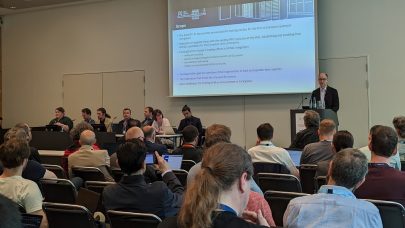
US Leads User Rush to Try China’s Quantum Computer
January 19, 2024
Global users have apparently rushed to try out Origin Wukong, “China’s top quantum computer,” which was opened to public access earlier this month. CGT Read more…

Rust Busting: IBM and Boeing Battle Corrosion with Simulations on Quantum Computer
October 3, 2023
The steady research into developing real-world applications for quantum computing is piling up interesting use cases. Today, IBM reported on work with Boeing to Read more…

Intel Debuts Tunnel Falls Quantum Chip and LQC Program to Work with It
June 15, 2023
Today, Intel announced its first silicon spin-based qubit quantum chip – Tunnel Falls – a 12-qubit research chip and a program intended to selectively share Read more…

Researchers Develop Integrated Photonic Platform Based on Thin-Film Lithium Niobate
June 3, 2023
Researchers are leveraging photonics to develop and scale the hardware necessary to tackle the stringent requirements of quantum information technologies. By ex Read more…

ISC BOF: Euro Quantum Community Tackles HPC-QC Integration, Broad User Access
May 23, 2023
Europe has clearly jumped into the global race to achieve practical quantum, though perhaps a step later (by a year or two) than the U.S. and China. Impressivel Read more…

Nvidia Announces Hybrid Classical-Quantum Lab at Jülich SC; Touts Rolls Royce Quantum Simulation
May 21, 2023
At ISC this week, Nvidia announced plans for a new hybrid classical-quantum computing lab with partners Jülich Supercomputing Centre and ParTec. The new lab is Read more…

Q&A with ORNL’s Travis Humble, an HPCwire Person to Watch in 2023
May 12, 2023
Travis Humble is the director the Quantum Science Center (QSC) at Oak Ridge National Laboratory. QSC is one of six National QIS Research established by the U.S. National Quantum Initiative Act (NQIA) in 2018 and being overseen by the Department of Energy. Hopes are high that these centers, through their own research and in collaboration... Read more…

IBM Opens Access to Latest Osprey Quantum Processor at 413 Qubits
May 9, 2023
Yesterday, IBM announced its newest quantum processor – Osprey – introduced last December is now accessible as an “as an exploratory technical demonstrati Read more…

- Click Here for More Headlines

Whitepaper
Why IT Must Have an Influential Role in Strategic Decisions About Sustainability
In this era, expansion in digital infrastructure capacity is inevitable. Parallel to this, climate change consciousness is also rising, making sustainability a mandatory part of the organization’s functioning. As computing workloads such as AI and HPC continue to surge, so does the energy consumption, posing environmental woes. IT departments within organizations have a crucial role in combating this challenge. They can significantly drive sustainable practices by influencing newer technologies and process adoption that aid in mitigating the effects of climate change.
While buying more sustainable IT solutions is an option, partnering with IT solutions providers, such and Lenovo and Intel, who are committed to sustainability and aiding customers in executing sustainability strategies is likely to be more impactful.
Learn how Lenovo and Intel, through their partnership, are strongly positioned to address this need with their innovations driving energy efficiency and environmental stewardship.
Download Now
Sponsored by Lenovo
Whitepaper
How Direct Liquid Cooling Improves Data Center Energy Efficiency
Data centers are experiencing increasing power consumption, space constraints and cooling demands due to the unprecedented computing power required by today’s chips and servers. HVAC cooling systems consume approximately 40% of a data center’s electricity. These systems traditionally use air conditioning, air handling and fans to cool the data center facility and IT equipment, ultimately resulting in high energy consumption and high carbon emissions. Data centers are moving to direct liquid cooled (DLC) systems to improve cooling efficiency thus lowering their PUE, operating expenses (OPEX) and carbon footprint.
This paper describes how CoolIT Systems (CoolIT) meets the need for improved energy efficiency in data centers and includes case studies that show how CoolIT’s DLC solutions improve energy efficiency, increase rack density, lower OPEX, and enable sustainability programs. CoolIT is the global market and innovation leader in scalable DLC solutions for the world’s most demanding computing environments. CoolIT’s end-to-end solutions meet the rising demand in cooling and the rising demand for energy efficiency.
Download Now
Sponsored by CoolIT
Advanced Scale Career Development & Workforce Enhancement Center
Featured Advanced Scale Jobs:
HPCwire Resource Library
HPCwire Product Showcase
© 2024 HPCwire. All Rights Reserved. A Tabor Communications Publication
HPCwire is a registered trademark of Tabor Communications, Inc. Use of this site is governed by our Terms of Use and Privacy Policy.
Reproduction in whole or in part in any form or medium without express written permission of Tabor Communications, Inc. is prohibited.

























